Margarete Lanner (1896–1981) was a German stage and film actress. She appeared in around 30 films during the silent era in a mixture of leading and supporting roles. She had a small part in Fritz Lang's classic Metropolis (1927).
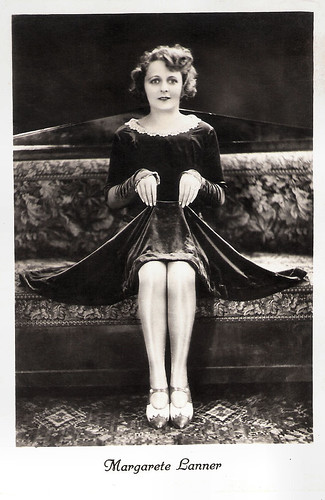
German postcard by H.C. Stöckel, Hannover-Linden for Bemberg. Caption: Bemberg-Strümpfe, Bemberg-Seide, Herz und Sinn erfreuen beide! (Bemberg stockings, Bemberg silk, delight both heart and sense!
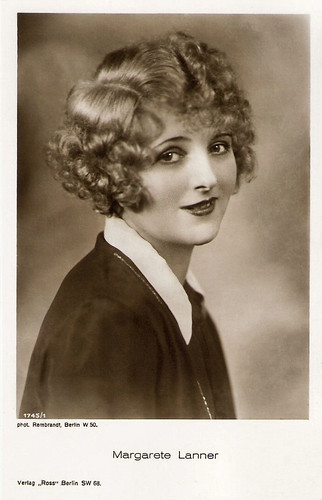
German postcard by Ross Verlag, no. 1745/1, 1927-1928. Photo: Rembrandt, Berlin.
Margarete Lanner (also Marga Lanner) was born Margarethe Helene Langlotz in 1896 in Hamburg, Germany.
In 1917, she made her stage debut run in Hanau. In 1919, she returned to her birthplace of Hamburg, where she received her first film contract from the production company Vera-Filmwerke GmbH, which was based there.
She made her first film appearances in Brutal (Paul Otto, 1919) and Colombine (Martin Hartwig, 1919) with Emil Jannings. In the latter, she played ‘the bride of the Apaches’. From then on, she easily found her way into the film business, and in the following years, she played leading roles in a dozen films for Vera-Filmwerke.
These include Der Staatsanwalt/The prosecutor (Paul Otto, 1920) with Werner Krauss, Das Geheimnis der grünen Villa/The Secret of the Green Villa (Philipp Lothar Mayring, 1921), Don Juan (Albert Heine, Robert Land, 1922) featuring Hans Adalbert Schlettow, Heines erste Liebe/Heine’s First Love (Eva Christa, 1922) and Die letzte Maske/The Final Mask (Emmerich Hanus, 1922).
In Sklaven der Rache/Slaves of Revenge (Philipp Lothar Mayring, 1921), Lanner even played a double role as two sisters.
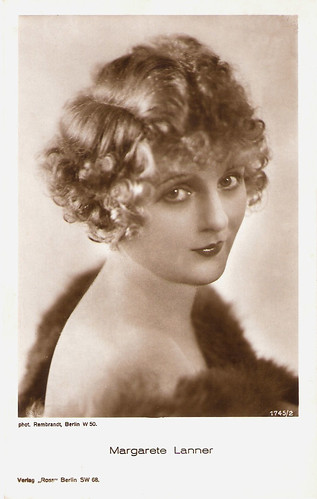
German postcard by Ross Verlag, no. 1745/2, 1927-1928. Photo: Rembrandt, Berlin.

Austrian postcard by Iris Verlag, no. 740. Photo: Treuhand-Film / Mondial A.G. Publicity still for In Treue stark/In faithful strong (Heinrich Brandt, 1926) with Angelo Ferrari.
Margarete Lanner could count on a devoted regular audience, but Vera-Filmwerke stopped producing films in 1924. She moved to Berlin, where she continued her film career. She played leading roles in unspectacular productions, such as the popular Ufa comedy Die zweite Mutter/The Second Mother (Heinrich Bolten-Baeckers, 1925) with Hans Mierendorff, and Des Lebens Würfelspiel/The Dice Game of Life (Heinz Paul, 1925), starring Frida Richard and Hella Moja.
Very spectacular is the expressionist Science Fiction masterpiece Metropolis (1927), Fritz Lang’s epic vision of a futuristic city where workers toil for their domineering overseers. However, Lanner’s part in the film was very small: she played a woman seen in a car and in the Eternal Gardens.
The following year she made her final silent film, Das Fräulein von Kasse 12/The Woman from Till 12 (Erich Schönfelder, 1928), starring Werner Fuetterer and Dina Gralla. She retired from the film business for a longer time.
She married and became Margarete Gräfin Aichelburg. Only in 1936, she made a brief comeback with two films for Euphono-Film GmbH, Die Stunde der Versuchung/The Hour of Temptation (Paul Wegener, 1936) starring Gustav Fröhlich, and Ein Lied klagt an/A song laments (Georg Zoch, 1936) with Louis Graveure.
After that, she disappeared largely from the public eye. She returned to the theatre as an actress and singer under the name of Marga Lanner. She had a commitment to the Municipal Theater of Innsbruck in the 1938-1939 season. In 1940 she narrated the short Austrian documentary Kinderhände – Künstlerhände/Children 's Hands - Artists' Hands (Ulrich Kayser, 1940), her final film credit. Margarete Lanner died in 1981 in Vienna, Austria. She was 84.
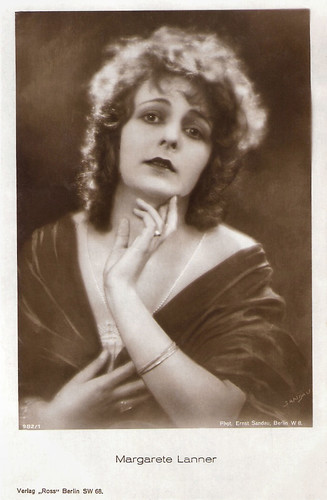
German postcard by Ross Verlag, no. 982/1, 1925-1926. Photo: Ernst Sandau, Berlin.
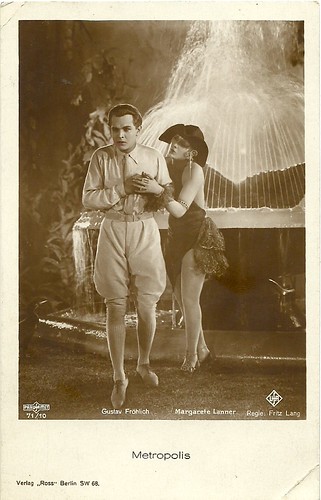
German postcard by Ross Verlag, Berlin, no. 71/10. Photo: Ufa / Parufamet. Publicity still for Metropolis (Fritz Lang, 1927) with Gustav Fröhlich. Collection: Didier Hanson.
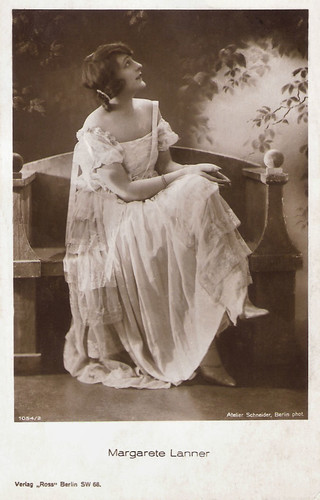
German postcard by Ross Verlag, no. 1054/2, 1927-1928. Photo: Atelier Schneider, Berlin.
Sources: Thomas Staedeli (Cyranos), BFI (Page now defunct), Wikipedia (German and English) and IMDb.
This post was last updated on 26 February 2025.

German postcard by H.C. Stöckel, Hannover-Linden for Bemberg. Caption: Bemberg-Strümpfe, Bemberg-Seide, Herz und Sinn erfreuen beide! (Bemberg stockings, Bemberg silk, delight both heart and sense!

German postcard by Ross Verlag, no. 1745/1, 1927-1928. Photo: Rembrandt, Berlin.
The bride of the Apaches
Margarete Lanner (also Marga Lanner) was born Margarethe Helene Langlotz in 1896 in Hamburg, Germany.
In 1917, she made her stage debut run in Hanau. In 1919, she returned to her birthplace of Hamburg, where she received her first film contract from the production company Vera-Filmwerke GmbH, which was based there.
She made her first film appearances in Brutal (Paul Otto, 1919) and Colombine (Martin Hartwig, 1919) with Emil Jannings. In the latter, she played ‘the bride of the Apaches’. From then on, she easily found her way into the film business, and in the following years, she played leading roles in a dozen films for Vera-Filmwerke.
These include Der Staatsanwalt/The prosecutor (Paul Otto, 1920) with Werner Krauss, Das Geheimnis der grünen Villa/The Secret of the Green Villa (Philipp Lothar Mayring, 1921), Don Juan (Albert Heine, Robert Land, 1922) featuring Hans Adalbert Schlettow, Heines erste Liebe/Heine’s First Love (Eva Christa, 1922) and Die letzte Maske/The Final Mask (Emmerich Hanus, 1922).
In Sklaven der Rache/Slaves of Revenge (Philipp Lothar Mayring, 1921), Lanner even played a double role as two sisters.

German postcard by Ross Verlag, no. 1745/2, 1927-1928. Photo: Rembrandt, Berlin.

Austrian postcard by Iris Verlag, no. 740. Photo: Treuhand-Film / Mondial A.G. Publicity still for In Treue stark/In faithful strong (Heinrich Brandt, 1926) with Angelo Ferrari.
Leading roles in unspectacular productions
Margarete Lanner could count on a devoted regular audience, but Vera-Filmwerke stopped producing films in 1924. She moved to Berlin, where she continued her film career. She played leading roles in unspectacular productions, such as the popular Ufa comedy Die zweite Mutter/The Second Mother (Heinrich Bolten-Baeckers, 1925) with Hans Mierendorff, and Des Lebens Würfelspiel/The Dice Game of Life (Heinz Paul, 1925), starring Frida Richard and Hella Moja.
Very spectacular is the expressionist Science Fiction masterpiece Metropolis (1927), Fritz Lang’s epic vision of a futuristic city where workers toil for their domineering overseers. However, Lanner’s part in the film was very small: she played a woman seen in a car and in the Eternal Gardens.
The following year she made her final silent film, Das Fräulein von Kasse 12/The Woman from Till 12 (Erich Schönfelder, 1928), starring Werner Fuetterer and Dina Gralla. She retired from the film business for a longer time.
She married and became Margarete Gräfin Aichelburg. Only in 1936, she made a brief comeback with two films for Euphono-Film GmbH, Die Stunde der Versuchung/The Hour of Temptation (Paul Wegener, 1936) starring Gustav Fröhlich, and Ein Lied klagt an/A song laments (Georg Zoch, 1936) with Louis Graveure.
After that, she disappeared largely from the public eye. She returned to the theatre as an actress and singer under the name of Marga Lanner. She had a commitment to the Municipal Theater of Innsbruck in the 1938-1939 season. In 1940 she narrated the short Austrian documentary Kinderhände – Künstlerhände/Children 's Hands - Artists' Hands (Ulrich Kayser, 1940), her final film credit. Margarete Lanner died in 1981 in Vienna, Austria. She was 84.

German postcard by Ross Verlag, no. 982/1, 1925-1926. Photo: Ernst Sandau, Berlin.

German postcard by Ross Verlag, Berlin, no. 71/10. Photo: Ufa / Parufamet. Publicity still for Metropolis (Fritz Lang, 1927) with Gustav Fröhlich. Collection: Didier Hanson.

German postcard by Ross Verlag, no. 1054/2, 1927-1928. Photo: Atelier Schneider, Berlin.
Sources: Thomas Staedeli (Cyranos), BFI (Page now defunct), Wikipedia (German and English) and IMDb.
This post was last updated on 26 February 2025.
No comments:
Post a Comment